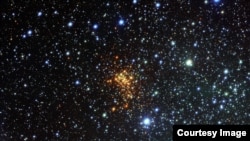The largest star in the known Universe is dying and will soon explode, astronomers said.
The star, named W26, is in the Westerlund 1 cluster of clouds, some 16,000 light years from Earth in the southern constellation of Ara. Westerlund 1 is the most massive cluster of stars in our galaxy, home to several hundred of thousand stars.
W26 has a radius 1,500 larger than the Sun and is one of the most luminous red supergiants known. Such stars are believed to be highly evolved, which suggests its coming to the end of its life and will explode as a supernova.
Some of the most massive stars have lifetimes of less than a few million years before they exhaust their nuclear fuel and explode. At the very ends of their lives, these stars become highly unstable and eject a considerable amount of material from their outer envelopes. This material has been enriched by nuclear reactions deep within the star and includes many of the elements necessary for forming rocky planets like our Earth, such as silicon and magnesium. Those elements are also the basis for life. How this material is ejected and how it affects the evolution of the star is still a mystery.
Astronomers from the UK, Chile, Germany and the U.S. spotted a cloud of glowing hydrogen gas, shown as green in this new image, using the Very Large Telescope Survey Telescope (VST) at the European Southern Observatory's Paranal Observatory in Chile.
Such glowing clouds are ionized, meaning that the electrons have been stripped away from the atoms of hydrogen gas. Clouds of this type are rarely found around massive stars and are even rarer around red supergiant stars such as W26. This is the first ionized nebula ever discovered around such a star.
The nebula observed around W26 is very similar to the nebula surrounding SN1987A, the remnant of a star that exploded as a supernova in 1987. SN1987A was the closest observed supernova to Earth since 1604 and as such, it gave astronomers a chance to better study the properties of these explosions. Studying objects like the new nebula around W26 will help astronomers to understand the mass loss processes around these massive stars, which eventually lead to their explosive demise.
The researchers publish their results in the Oxford University Press journal Monthly Notices of the Royal Astronomical Society.
The star, named W26, is in the Westerlund 1 cluster of clouds, some 16,000 light years from Earth in the southern constellation of Ara. Westerlund 1 is the most massive cluster of stars in our galaxy, home to several hundred of thousand stars.
W26 has a radius 1,500 larger than the Sun and is one of the most luminous red supergiants known. Such stars are believed to be highly evolved, which suggests its coming to the end of its life and will explode as a supernova.
Some of the most massive stars have lifetimes of less than a few million years before they exhaust their nuclear fuel and explode. At the very ends of their lives, these stars become highly unstable and eject a considerable amount of material from their outer envelopes. This material has been enriched by nuclear reactions deep within the star and includes many of the elements necessary for forming rocky planets like our Earth, such as silicon and magnesium. Those elements are also the basis for life. How this material is ejected and how it affects the evolution of the star is still a mystery.
Astronomers from the UK, Chile, Germany and the U.S. spotted a cloud of glowing hydrogen gas, shown as green in this new image, using the Very Large Telescope Survey Telescope (VST) at the European Southern Observatory's Paranal Observatory in Chile.
Such glowing clouds are ionized, meaning that the electrons have been stripped away from the atoms of hydrogen gas. Clouds of this type are rarely found around massive stars and are even rarer around red supergiant stars such as W26. This is the first ionized nebula ever discovered around such a star.
The nebula observed around W26 is very similar to the nebula surrounding SN1987A, the remnant of a star that exploded as a supernova in 1987. SN1987A was the closest observed supernova to Earth since 1604 and as such, it gave astronomers a chance to better study the properties of these explosions. Studying objects like the new nebula around W26 will help astronomers to understand the mass loss processes around these massive stars, which eventually lead to their explosive demise.
The researchers publish their results in the Oxford University Press journal Monthly Notices of the Royal Astronomical Society.












